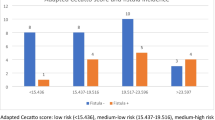Abstract
To analyse pharyngocutaneous fistula, post Pectoralis major myocutaneous patch pharnygoplasty, and its association with various tumor, patient and treatment related factors. It is a retrospective study that included 48 patients who underwent laryngectomy and PMMC patch pharyngeal reconstruction from year 2009 to 2013. We studied the previously reported factors that could influence fistula formation such as age, gender, previous radiotherapy, previous tracheostomy, location of tumor, extent of tumor, tumor volume, tumor stage and surgical margins. Pharyngocutaneous fistula was observed in 13(27.1 %) cases. In 84.6 % (n = 11) patients, fistula closure was achieved by conservative measures. No statistically significant association was found between tumor location, extent and size. There was no association between history of previous tracheostomy and postoperative microscopic margin status. Patients with T4 disease showed increased association (36.7 %) compare to T3 stage (11 %) (p value-0.0362). Postoperatively 6 patients presented with dysphagia out of which 4 patients (66.7 %) had history of leak. It also showed significant increase in post operative stay and delay in oral feeding in fistula patients. There is still no consensus regarding the most significant risk factors, our data showed that, most disease and treatment related parameters were not predictive for fistula occurence. Prabably a larger number of patient cohart need to be analysed for additional information.
Similar content being viewed by others
References
Bresson K, Rasmussen H, Rasmussen PA (1974) Pharyngocutaneous fistulae in totally laryngectomized patients. J Laryngol Otol 88:835–842
Thawley SE (1981) Complications of combined radiation therapy and surgery for carcinoma of the larynx and inferior hypopharynx. Laryngoscope 91:677–700
Cousins VC, Milton CM, Bickerton RC (1987) Hospital morbidity and mortality following total laryngectomy. J Laryngol Otol 101:1159–1164
Dedo D, Alonso WA, Ogura JH (1975) Incidence, predisposing factors and outcome of pharyngocutaneous fistulas complicating head and neck cancer surgery. Ann Otol Rhinol Laryngol 84:833–840
Lundgren J, Olofsson J (1979) Pharyngocutaneous fistulae following total laryngectomy. Clin Otolaryngol 4:13–23
Wei WI, Lam KH, Wong J, Ong GB (1980) Pharyngocutaneous fistula complicating total laryngectomy. Aust N Z J Surg 50:366–369
Arriaga MA, Kanel KT, Johnson JT, Myers EN (1990) Complications in total laryngectomy: incidence and risk factors. Ann Otol Rhinol Laryngol 99:611–615
Hier M, Black MJ, Lafond G (1993) Pharyngo-cutaneous fistulas after total laryngectomy: incidence, etiology and outcome analysis. J Otolaryngol 22:164–166
Gil Z, Gupta A, Kummer B, Cordeiro PG, Kraus DH, Shah JP (2009) The role of pectoralis major muscle flap in salvage total laryngectomy. Arch Otolaryngol Head Neck Surg 135(10):1019–1023
Saki N, Nikakhlagh S, Kazemi M (2008) Arch Pharyngocutaneous fistula after laryngectomy: incidence, predisposing factors, and outcome. Iran Med 11(3):314–317.
Rzepakowska A, Osuch-Wójcikiewicz E, Ochal-Choińska A, Bruzgielewicz A (2011) Pharyngocutaneous fistula as a complication after total laryngectomy--clinical study and literature review. Otolaryngol Pol 65(5 Suppl):22–30
Cavalot AL, Gervasio CF, Nazionale G, Albera R, Bussi M, Staffieri A, Ferrero V, Cortesina G (2000) Pharyngocutaneous fistula as a complication of total laryngectomy: review of the literature and analysis of case records. Otolaryngol Head Neck Surg 123(5):587–592
White HN, Golden B, Sweeny L, Carroll WR, Magnuson JS, Rosenthal EL (2012) Assessment and incidence of salivary leak following laryngectomy. Laryngoscope 122(8):1796–1799. doi:10.1002/lary.23443
Author information
Authors and Affiliations
Corresponding author
Rights and permissions
About this article
Cite this article
Lakhera, K.K., Shenoy, A.M., Chavan, P. et al. Pharyngocutaneous Fistula Incidence After PMMC Patch Pharnygoplasty for Post Laryngectomy Defect Reconstruction – Predictive Factors, Our Experience at KMIO. Indian J Surg Oncol 6, 223–226 (2015). https://doi.org/10.1007/s13193-015-0423-y
Received:
Accepted:
Published:
Issue Date:
DOI: https://doi.org/10.1007/s13193-015-0423-y




